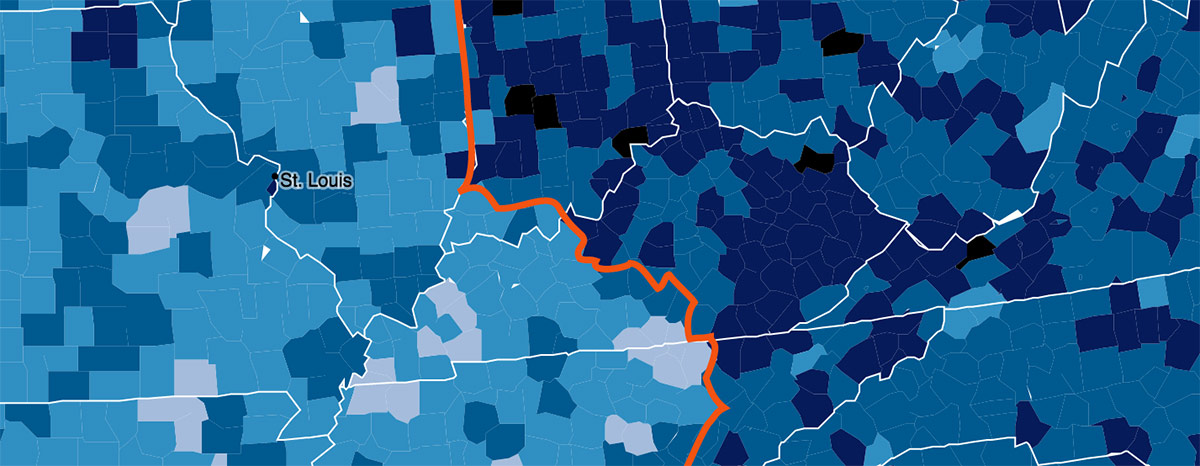Where I live in Brooklyn, the sun will set today at the depressingly early time of 4:45p.m. In Louisville, the sun sets tonight at 5:40p.m. That’s an extra hour of sunlight between the eastern and western edges of the Eastern Standard Time zone. That effect is repeated across the United States as zigzagging time zones slice the country into pieces.
Data scientists at health-tech company Jawbone have taken data from its users and mapped it county-by-county across the U.S. to show the average times Americans hit the sack. Unsurprisingly, there are some drastic bedtime differences along the time zone borders, most dramatically seen in Kentucky.
The circadian rhythm phenomenon on display here seems simple enough and shows how our biological clocks respond to natural daylight over the more arbitrary arms of a clock. Here’s how Jawbone described it on its blog:
The average difference in bedtime across the time zone border is 16 min…, and some places it’s as high as 30 minutes. But why?
1. Imagine two people in Kentucky, very close to each other but on opposites sides of the time zone border. If they both go to bed 4 hours after the sun goes down, their clocks will say that the person in Eastern Time went to bed one hour later than the person in Central Time.
2. Now let’s look at the Central Time Zone. It’s 6pm, and the sun has gone down in the middle of Kentucky. It’s also 6pm in western Kansas, almost 1000 miles away, but the sun will not go down for another hour. So people go to bed later in the western edge of the timezone than the eastern edge.
Unbeknownst to us, our body’s circadian rhythms tune to sunlight hours, silently influencing you to go to bed when the sun goes down irrespective of the exact time.
And here’s a look at Kentucky zoomed in:
As you can see, according to Jawbone’s data, the average person in Jefferson County goes to sleep at 11:38p.m., the latest of any county in Louisville’s metropolitan statistical area that includes Southern Indiana. Oldham County also goes to sleep at 11:38 while Trimble County knocks off earliest at 11:28p.m. Carter County in far eastern Kentucky stays up the latest, with an average 11:52 bedtime, according to the map.
Nationwide, Jawbone noticed that places with an active nightlife tended to stay up latest. Despite the sun setting an hour earlier, Brooklyn goes to sleep latest at 12:07a.m. The rest of New York City, along with Las Vegas, Miami, New Orleans, and Atlantic City, represent the latest bedtimes. Some remote college towns are also night owls, ostensibly up late studying.
Below, Jawbone also mapped its data on total hours of sleep by county, with Jefferson clocking in at 6.91 hours a night, just shy of the seven hours recommended by the National Institute of Health.
What conclusions do you draw from these maps and the data they represent? Clearly, the data is generated from a self-selecting group that uses Jawbone’s health-tracking devices, so there’s bound to be some variation from the general public. Rural counties are also likely to have more skewed numbers since there’s a lower sample to collect data from, whereas data from urban areas is collected from a larger group. The results are fascinating nonetheless.
Click on over to Jawbone’s blog to play around with the interactive versions of these maps.






I was looking at historic time zone one day out of curiosity. Louisville before the standardization was one of the few cities with a half-hour offset. It was essentially set at the half-hour between today’s Eastern and Central time. It’s an easy joke that some Louisvillians are always a half-hour late to events because they are still running on old Louisville time…
The other random fact I tend to trot out discussing Louisville time zones is that the reason the Eastern time zone juts out around Louisville (making it the western-most city of the time zone) is (celebrate it or complain about it) because GE thought it would be easier if Louisville, Cincinnati, and New Jersey/New York were all in the same time zone.
Correction: “one of the western-most”
Louisville also sells alcohol in bars and stores until 4 am, which might influence the nightlife part and times to bed, further muddying the waters.
I wish they would put a stop to changing of the clock it makes no sense.